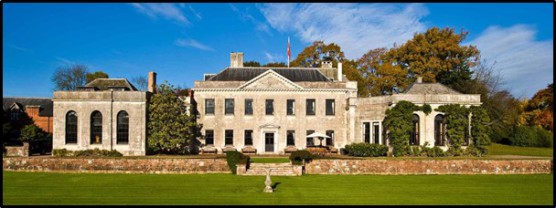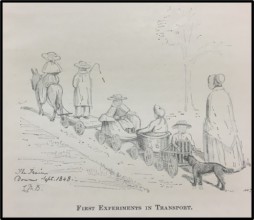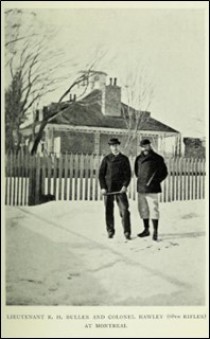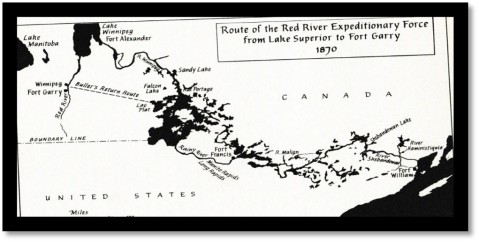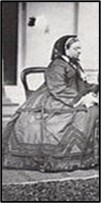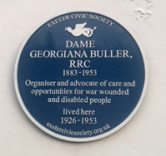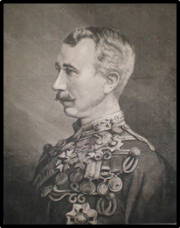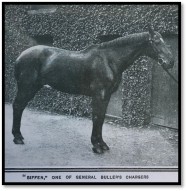
General Sir Redvers Buller VC (1839-1908)
In his Own Time and Our Time
with Dr. Robert Guyver on Thursday, 9 November 2023 at 7pm at The Mint, Exeter
We were a more select group than usual, having had to relocate to a smaller venue (the Wesley Room at the Mint Methodist Church) after the flooding at Leonardo Hotel. However, Robert Guyver sportingly agreed to deliver his talk in the new location, and he was introduced by Neil Ward, who explained that Robert, a local historian, spent his working life in education and research. He is also a published writer and has been particularly interested in the topic of history education across the Commonwealth.
Robert began by explaining that Buller has recently become a more controversial figure with two phases of objections being raised to the presence of Buller’s statue near the Clock Tower in Exeter. Robert talked about the purposes of military presence or interventions, and these are mainly trade, (maintenance of peace, punitive measures to enforce control over trade), maintaining colonial boundaries, resisting incursions by other colonial powers, supporting other powers in their struggle to resist military force, and rescue missions in any of the above.
Redvers Buller was the third child in a family of ten children, born 7th December 1839. His father was James Buller (1798 - 1865) and his mother was Charlotte Juliana Jane [née Howard-Molyneux-Howard] (1809 - 1855), third daughter of Lord Henry Thomas Howard-Molyneux-Howard, Deputy Earl Marshal, and younger brother of Bernard Howard, 12th Duke of Norfolk. His mother died rather shockingly in the waiting room of Exeter St. David’s station in the presence of Redvers, on the 15th December 1855. Redvers was just 16! Buller was initially educated at Harrow, where he was very unhappy, so his parents moved him to Eton College. He gained practical and outdoor skills from estate workers in the school holidays. The picture on the left shows an early experiment in transport!
Redvers Buller was commissioned on July 14th, 1858, at the age of 18, as an Ensign in the 60th Foot (later the 2nd Battalion of the Royal Green Jackets - the King’s Royal Rifle Corps). This was paid for with the sum of £450. He joined the Rifle Depot at Winchester and was sent to India towards the end of the Indian rebellion. He was then posted to China, where he fought in the second Opium war. Buller was present at the storming of the Summer Palace, under orders from Lord Elgin, and took some items as presents for his family.
Subsequently he was posted to Canada. This photo shows Lt. Buller at Montreal with Colonel Hawley (60th Rifles) Hawley gave Buller a great opportunity when he offered him the role of Adjutant. Buller was not afraid to speak his mind, for example over the suitability of certain men for promotion. Buller was trusted by those serving under him. He was keen and tough with good leadership skills. These were noted by Sir Garnet Wolseley on the very challenging Red River Expedition in Canada in 1870, and he gained entrance into Wolseley's 'ring' of favourites. In 1879, Buller served also as a lieutenant-colonel in the Frontier Light Horse, part of Evelyn Wood’s number 4 column. He led Wood’s main attacking force in the battle of Hlobane but the Zulus were too numerous and a retreat was ordered. The descent through Devil's Pass was a dangerous undertaking and there were many acts of bravery. When most of them, under Buller's leadership, had reached the camp, after dark, it was discovered that some men of Captain Barton's troop had been left behind. Buller returned immediately to look for them and rescued 3 men. For this action he won the VC.
Praises were heaped on Buller, and he was appointed ADC to Queen Victoria, with whom he got on well. Soon after he married Audrey, daughter of the Marquess of Townshend. Buller’s honeymoon was interrupted to enable him serve under Wolseley in Egypt. He fought at the Battle of Tel-El-Kebir (13th September 1882) But it wasn't all plain sailing. He had a strong personality which caused him to disagree with fellow officers, including Wolseley himself at one point. Another significant strained relationship with the Prince of Wales, whose fast social set Buller avoided. After the Prince of Wales acceded to the throne in 1901, he would not support Buller when he was in trouble that year.
On his return from Egypt, Buller was sent to the Sudan where he fought in the Mahdist war between Sudanese followers of Mohammed bin Abad Allah, and the Egyptian backed overlords. He fought in the battles of El Teb and Tamai (1884) and was part of the Expedition that failed to rescue General Gordon in Khartoum (January 1885), as a result of a wrong decision by Wolseley, which involved the relief force travelling by a long circuitous route, resulting in failure to relieve General Gordon in time. Buller had his idiosyncrasies, namely his high consumption of champagne when campaigning. Guests at Buller’s headquarters, (and these included both important civilians and foreign military attaches), would have expected to find champagne there, often served in a tankard. (Geoffrey Powell, Buller – A Scapegoat, Leo Cooper, 1994, p. 159, in Chapter on ‘Black Week’) Buller also took a wide range of literature with him when on campaign, and this included poetry and novels.
After his return from Egypt and the Sudan, Buller was employed first as Quarter-master General and then as Adjutant-General to Wolseley at the War Office. He was virtually running the army himself since the Duke of Cambridge was increasingly incapacitated. During this time, he set up the Army Service Corps which was a great boon to all soldiers. His regard for the well-being of soldiers made him very popular. In 1886, the new Conservative Government appointed him Special Commissioner for the Irish Counties of Kerry and Clare, with the task of restoring law and order. He was held in high regard by Irish peasants. Even in 1922, after Ireland had gained Home Rule, he was remembered as the soldier who negotiated impartially with both sides to bring peace to Kerry, and to slow down the rate of evictions.
In 1898 Buller became head of the troops stationed at Aldershot. He was sent as commander of the British Expeditionary Force in 1899 on the outbreak of the Second Boer War. He arrived in October and suffered a defeat at the Battle of Colenso. Defeats at the Battle of Magersfontain and Stormberg also involved forces under his command. Because of these defeats he was replaced as commander by Lord Roberts. Buller pressed on however to relieve Ladysmith. Buller correctly predicted that the Boers would take to guerrilla warfare after their defeat at Bloemfontaine. When Buller returned to the UK he was greeted as a hero, but subsequently became a scapegoat when the Boers continual guerrilla activities affected public confidence in the British Army. He was sacked on the 22nd October 1901, as a result of a speech he had a few days earlier when responding to an attack by Times journalist Leo Amery, which was seen as breaching military discipline. However, Buller remained popular with the public, and a statue of him (by Adrian Jones) on his horse Biffen, was erected to honour him – paid for by public subscription. The statue was designated as a Grade 2 listed building in 1953. It was unveiled in 1905 in Buller’s presence. Buller died in 1908 and was buried in Crediton.
Buller’s legacy - our speaker pointed out that contemporary attacks on Buller came in two forms; Firstly that he was a poor General. This has been refuted by some historians such as Geoffrey Powell who did his best to restore Buller’s reputation, and Thomas Pakenham who has defended Buller in his book “The Boer War”. Buller often found himself uncomfortable with the decisions of officers senior to him, like Wolseley and Roberts. Roberts, acting with Lord Broderick, a politician, decided to end Buller’s career. Buller was certainly blamed for a string of early defeats in the Boer War , but he was not responsible for the high civilian casualty rate associated with the internment camps in the war’s later stages, and subsequently so widely criticised.
He could sometimes be indiscreet, and he had admitted in a telegram to Sir George White, that White might consider surrender to the Boers at Ladysmith, to save the lives of the besieged.
Secondly Robert pointed out that in recent times there has been opposition to the very existence of Buller’s statue, which has been seen to imply approval of imperialism and maybe even racism. As a consequence of the Black Lives Matter movement and general cultural changes, there has been a wave of criticism of the British Empire, which many see as being both encapsulated and celebrated in military and colonial statues. Exeter City Council contemplated moving the Buller statue but has compromised by erecting information boards which seek to contextualise Buller’s career in the light of current thinking.
Robert’s talk was very thought provoking and informative, and we all learnt something new.
